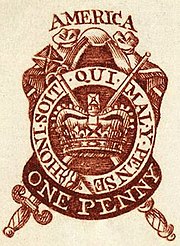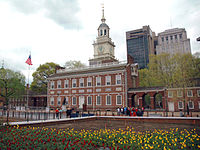
Back Stamp Act Congress Esperanto Stamp Act Congress French קונגרס חוק הבולים HE Stamp Act Congress ID Congresso dello Stamp Act Italian 印紙法会議 Japanese Stamp Act Congress Portuguese Конгресс Гербового акта Russian
Stamp Act Congress/Continental Congress | |
|---|---|
| Part of the American Revolution | |
 | |
| Type | |
| Type | |
| History | |
| Established | October 7, 1765 |
| Disbanded | October 25, 1765 |
| Preceded by | Albany Congress |
| Succeeded by | 1st Continental Congress |
| Leadership | |
Chairman of the Congress | |
| Seats | 27 |
| Meeting place | |
 | |
| City Hall (later Federal Hall, since demolished) New York, New York | |
| This article is part of a series on the |
| United States Continental Congress |
|---|
 |
| Predecessors |
| First Continental Congress |
| Second Continental Congress |
| Congress of the Confederation |
| Members |
| Related |
|
|
The Stamp Act Congress (October 7 – 25, 1765), also known as the Continental Congress of 1765, was a meeting held in New York City in the colonial Province of New York. It included representatives from most of the British colonies in North America, which sought a unified strategy against newly imposed taxes by the British Parliament, particularly the Stamp Act. It was the second such gathering of elected colonial representatives after the Albany Convention of 1754 at the outbreak of the French and Indian War. Massive debts from that war, which ended in 1763, prompted the British Parliament to implement measures to raise revenues from the colonies. The Stamp Act required the use of specialty stamped British paper for all legal documents, newspapers, almanacks, and calendars, and even playing cards and dice. When in force, it would have an impact on practically all business in the colonies, starting on November 1, 1765. Resistance to it came especially from lawyers and businessmen, but was broadly protested by ordinary colonial residents.
Delegates from nine colonies attended the Congress. All of the attending delegations were from the Thirteen Colonies that eventually launched the American Revolution, breaking from British colonial rule to form the United States of America. Although sentiment was strong in some of the other colonies to participate in the Congress, a number of royal governors took steps to prevent the colonial legislatures from meeting to select delegates.
The Congress met in the building where Federal Hall now stands and was held at a time of widespread protests in the colonies, some violent, against the Stamp Act's implementation. The delegates discussed and united against the act, issuing a Declaration of Rights and Grievances in which they claimed that Parliament did not have the right to impose the tax because it did not include any representation from the colonies. Members of six of the nine delegations signed petitions addressed to Parliament and King George III objecting to the Act's provisions.
The extralegal nature of the Congress caused alarm in Britain, but any discussion of the congress's propriety were overtaken by economic protests from British merchants, whose business with the colonies suffered as a consequence of the protests and their associated non-importation of British products. The economic issues prompted the British Parliament to repeal the Stamp Act, but it passed the Declaratory Act the same day, to express its opinion on the basic constitutional issues raised by the colonists; it stated that Parliament could make laws binding the American colonies "in all cases whatsoever."[1]
- ^ "America During the Age of Revolution, 1766–1767". Library of Congress. Retrieved March 22, 2012.
© MMXXIII Rich X Search. We shall prevail. All rights reserved. Rich X Search